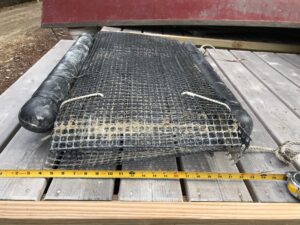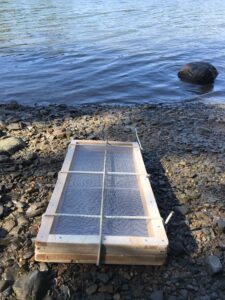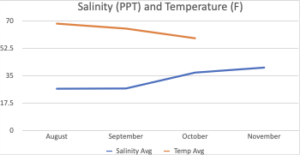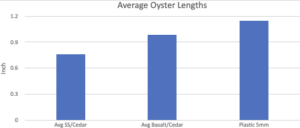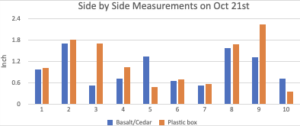Final report for FNE21-988
Project Information
We sought to identify durable, inexpensive, ecologically friendly materials for aquaculture systems, especially oyster cultivation. At the most basic level, our goal was to figure out which materials are the best for the job - in performance, supply, and durability, and that meet our ecological goals. Furthermore we generated preliminary data and information for other aquaculturists to adopt, adapt, and continue our work.
Oceanic plastics present a major environmental concern, and the use of plastics in modern aquaculture contribute to this problem: lost gear and degraded plastics from conventional materials damage habitat and decrease water quality. There is also no established best practice for aquaculture that does not involve use of plastic gear, nor is there any market, production standard/ certification or financial incentive to venture into non-plastic aquaculture where no identified solution yet exists.
We undertook an investigation of available, experimental and applicable bio-materials for floating oyster bags and seaweed lines and line floats. We collaborated with materials scientists, design labs and pioneering ecological building materials companies to identify and try out alternative gear approaches and application for our farms in Maine. In time, we believe this research will lead to greater standardization of best practices for low-pollutant aquaculture, increasing the viability of non-plastic gear by incentivizing their use through certification, low-input technologies, and high-quality products.
This project sought to:
- Identify and obtain an assortment of materials to test in the design and construction of plastic-free aquaculture gear.
- Select two to three high-performing materials and designs to scale-up testing to a small commercial operation in the 2021 growing season.
- Conduct in situ side-by-side performance comparison with commercially available plastic oyster grow-out surface bags and ropes.
- Record biotic and abiotic parameters along with gear status bi-monthly to determine efficacy of alternative gear.
- Analyze data and gear performance at project conclusion. Disseminate results in a user-friendly format.
- Report results and potential of materials at public events held by Greenhorns for public outreach, as well as with local SEAGRANT, Local Catch network, Slow fish USA, Maine Aquaculture Association and East Coast Shellfish Growers Association, as well as informally through regional aquaculture and sea farmer networks.
The annual excess of eight million tons of plastic pollution entering the marine environment is expected to increase twenty-fold by 2050. It is estimated that approximately 20% of the plastic in the ocean comes from on-the-water activities, such as fishing and aquaculture. While the amount of plastic entering the marine environment is projected to increase, the average size of individual plastic particles is decreasing, due to the constant degradation of plastic pieces into progressively smaller fragments through chemical, biological and physical processes. These small pieces, <5 mm in size, are called microplastics.
Plastics are made with a range of chemicals during production (dyes, flame retardants, phthalates, antimicrobials) and have the ability to absorb and concentrate hydrophobic persistent organic pollutants (POPs) such as PCBs (polychlorinated biphenyls), PAHs (polyaromatic hydrocarbons), DDTs (dichlorodiphenyltrichloroethane), and nonphenyls (Rochman et al., 2013; Zhang et al., 2015). Ingestion of microplastic can lead to the introduction and bioaccumulation of these toxins into the aquatic food chain. Studies show microplastics have a wide ranging effects on marine invertebrates including inflammation (Browne et al., 2008), reduction of survival, growth and fecundity (Cole et al., 2015), lower activity and energy (Wright et al., 2013), and impedance of larval development (Sussarellu et al., 2016).
Globally, the aquaculture industry contributes to half of the seafood supply consumed annually. The microplastic load in the ocean is increasing rapidly and with it, the quantity of plastic consumed by humans- about 50,000 particles or ½ pound each year. Although the short- and long-term human health impacts from ingesting plastic are still not well understood, it is best to operate under the precautionary principle and take actions to reduce or remove plastic from our aquaculture environment as much as possible.
Standard gear for commercial aquaculture is almost entirely plastic - plastic that degrades in saltwater and ultimately contributes to a looming crisis of oceanic pollution. Many of the small-scale aquaculture entrepreneurs we talk to are interested in using non-plastic, low-pollution gear - but without a vetted proof of concept, the risks associated with adopting new gear are expensive and time-consuming. In short, research into non-plastic materials must be performed with a grant or other outside funding.
Performing research into alternative materials and presenting results will pave the way for these materials to be adopted, meaning that workable alternatives to plastic would be available for new and expanding ocean farmers. This will provide ecologically-minded farmers with what they are looking for, while helping cut down on the plastic released into the environment. A handful of oyster farmers we know have already assisted with the design, build, and implementation of early trial runs. In addition, there are dozens of small aquaculture businesses growing oysters in Maine, and increased public funding for diversified ocean farming and harvesting will only increase interest in these businesses. Thus, there is an emergent and expanding group of farmers who could benefit from our work.
In addition to the improvement of water quality and protection of natural resources that comes with plastic reduction, this project approach can be an effective means of reducing the costs of production and/or increased opportunity for employment. On one hand, plans for self-made gear that is proven to be effective can help to lower operating costs (at least at a small scale) by eliminating much of the cost of commercial gear. On the other hand, a cottage industry of non-plastic gear manufacturing for larger operators could help return the expenses of operation to local makers. This addresses another concern, which is the long-term viability of small-scale aquaculture as large firms maintain market dominance, and as lobstering and other marine economic activity becomes increasingly unstable. This project supported producers and the approach offers viable pathways to sustainable practices that are economically achievable, supporting resilient coastal communities and working waterfronts.
Smithereen Farm is a land based organic farm on Cobscook Bay. We grow a diverse agroforestry system including livestock, orchards, soft fruit, wild harvest, herb gardens and currants with a strong emphasis on native fruit. We also manage a blueberry barren and cranberry bog, a seaweed and oyster lease, and a log mushroom enterprise. All of the fruits of our harvest are processed into value added products such as seaweed sprinkle, blueberry jam etc. As part of our quest for maximizing the return on each enterprise, we want to create a higher standard of care for the wild ecosystem where we grow our mariculture— the alternatives to plastic project grew from our desire to raise these ocean foods without harm to the ocean. Ultimately we hope to set principled ecological market standards that will command a fair price for taking the best possible care of the natural resources here in beautiful, remote Washington County, allowing us to stay small, stay beautiful, and stay home! Because our farm is also campus to Greenhorns, a young farmers organization, we wish to make all our enterprises into action research projects where visitors and guests can learn from our mistakes and help us stretch our vision for truly regenerative practices.
Long Cove sea Farm is a 2.45 acre standard lease in Deer Isle, Maine. The farm strives to reduce it’s environmental impact in every facet of the business and improve water quality and general ecology in local waters. Long cove is women-owned and operated. The business strives to increase access to locally grown, sustainable seafood. Approximately 2/3 of the lease is under oyster (Crassostrea virginica) cultivation using floating surface bags. Oysters are tended between May and November each year. The farm is reseeded with 80k-100k oyster spat each spring. Long Cove oysters are sold almost exclusively on-island (Deer Isle & Stonington). Owner Abby Barrows holds a BSc in Zoology from the University of Tasmania and a M.Phil from College of the Atlantic (COA). She has worked in the marine sciences for over a decade, focusing predominantly on microplastic pollution in global aquatic environments, publishing four peer-reviewed papers on her research.
Cooperators
- - Technical Advisor
Research
Site descriptions
The experiment took place at the 2.45 acre standard aquaculture lease PENLD3 of Long Cove Sea Farm in Deer Isle, Maine, with additional testing taking place at Smithereen Farm's LPA SFLE1/2 off Leighton Point in Pembroke, ME.
Experimental Design
Incorporating our preliminary research on bio-materials (flotation devices: cork, pumice, mycelium, coir fiber, coconuts, as well as natural rubber coating over sunflower stalk Styrofoam; rope: raimie, traditional pine tar’d manila ropes, linen, and hemp; mesh/screens, basalt mesh, metal mesh, and slatted wooden crates) we designed and built two prototypes for 2021 season deployment. In June 2021 one prototype of alternative gear (2 mm mesh size bag) was set out with a minimum of 10,000 baby oysters per bag. Unfortunately, many of those babies were lost and we obtained more baby oysters in August and after some gear modification, we set out another round in August using 4mm mesh and 4-6mm oysters. These are both referred to as Prototype 1. Prototype 1 was made with cedar and stainless or aluminum window screen. The bag was secured/closed using very tight bungee cords but even so, the wood moved enough to create a small opening which allowed 1,000’s of 2.5 mm oysters to slip out. We modified this by screwing the two sides of the ‘bag’ together and did not suffer any more losses after that point.
Oyster spat was lost out of the prototypes for a few different reasons. In short, it was due to the prototype experimental process. For the 2mm prototype, the wood was planned and joined but still managed to warp enough in the water, created a less that flush surface between the top and bottom sections of the ‘bag’. These small openings were enough to allow for the babies to work their way out through wave action and current. The bungees could not be made sufficiently tight to hold the wood flush. Once this was realized we used fasteners to hold the top and bottom sections together.
For the 4mm prototype (Prototype 1) some wood glue was used which caused a strange reaction with the seawater and created a slight gap, where some oysters were lost. Ultimately, we lost oysters through a couple rips/tears in the basalt mesh. We speculate that these openings happened through larger birds (cormorants, eagles) landing on the bags. We do not know for certain though as the mesh seemed pretty rugged when handling.
In August 2021, a 5 mm mesh size bag (Prototype 2) was set out in tandem with plastic gear. Images of gear included below. This prototype was also made of cedar, but by a different carpenter— better fitting— and thinner wood. It turns out that the wood doesn’t need to be very thick, as we learned from traditional lobster cages. A few of the Prototype 2 5mm basalt mesh prototypes ripped, presumably from bird roosting. Unfortunately, this caused for more oyster loss late in the season.
The prototypes we created were made from Cedar wood and cork. One size for babies with mesh, and one size for bigger oysters with just slats. In addition we did several cork surface treatments and tried out many rope materials in the water. Since the project’s conclusion, we have doubled down on mycelium foam buoy production with project partner Sue Van Hook, mycologist.
The small mesh size (2mm opening) prototype had a frame of cedar wood and used stainless steel mesh (2mm) for the top and bottom. The prototype was fasted using stainless steel screws and bungees. This prototype was placed inside a three or four- compartment oyster ranch (prototype n= 11). One of these prototypes was built with slightly smaller dimensions and was placed inside an existing 1-inch mesh oyster grow bag.
The medium mesh size (4mm opening) Prototype 1 also had a frame of cedar wood but used basalt mesh (4mm) on the top and bottom. The prototypes were mostly fastened with stainless steel screws (a few had a mix of other metal types) and two used a hinge to hold the top and bottom together when opening. Some of the wood was treated with natural finish. The medium mesh prototype (n=4) also used large eyehooks for running rope through for attachment to the surface floating line. We also used these eyehooks for the rope which held the cork floats to the bag. We found that these corks were not necessary as the wood was buoyant enough without them and over time.
Data collection
Water temperature data was recorded continuously throughout the 2021 season. Additional data, was recorded opportunistically until the oysters outgrew the prototypes in October 2022. Colder water means less biofouling. The bags were inspected each sampling event. We ran into some issues and lost oysters in our 2mm bag. An empty basalt mesh bag was winterized with the rest of the farm in November 2021 and we will assess its condition in Spring 2022. During each sampling observational data about the prototypes (reported above) was recorded for each prototype (the oyster loss meant less data was collect than originally projected). Water temperature and salinity data is reported below in the Results and Discussion section.
Each prototype was assessed based on functionality, oyster growth and mortality. Since we had substantial oyster seed loss before growth data could be collected, we did not have as many numbers to work with as planned in terms of having clear growth projections for the different gear types (see Figures 2 and 3). We collected salinity and temperature data, creating a baseline of information for other farms to compare to and for us to build upon in the years to come (Figure 1). Unfortunately, the temperature logger had a glitch from July 23- August 19th and did not record temperatures for that time. Below are tables showing the temperature data (°F) for Long Cove:
|
Table 1: Long Cove Sea Farm Temperature Data 5/6/21-7/23/21
|
|
|
Samples
|
111914
|
|
Max
|
76
|
|
Min
|
50
|
|
Avg
|
62
|
|
Std Dev
|
4.51
|
|
Table 2: Long Cove Sea Farm Temperature Data 8/19/21-10/08/21
|
|
|
Samples
|
1197
|
|
Max
|
74
|
|
Min
|
59
|
|
Avg
|
65
|
|
Std Dev
|
2.67
|
Figure 1. (left) Salinity and temperature data at Long Cove Sea Farm from August-November. Note slight correlation of decreasing temperature with increasing salinity. Rain events not noted on graph.
Figure 2. (center) Random measurement of 10 oyster lengths from different bag types. Note that oysters in Stainless Steel (SS) bags started as 2.5 mm seed. Oysters in 5mm basalt mesh were oysters grown in the SS bags from 2.5 mm seed and upgraded into the larger mesh. Oysters in Plastic box started as 4-6 mm seed.
Figure 3. (right) Graph showing random subsampling of oyster lengths from non-plastic and plastic bags. An ANOVA test shows no significant different between the two groups, P>0.05. Additional oyster measurements are recommended as oysters grow over the next year, as this will give a more accurate measurement of growth to market size.
We identified and deployed natural materials for our commercial aquaculture operations. This project has only just begun, and our team continues to grow as do the many leads and prototypes made possible through this grant.
The public exposure of this grant has brought positive attention to our farms and with it positive relationships and energy. We have even considered creating a best practices standard for "plastic-free aquaculture" that could help with market differentiation for small producers on the coast of Maine.
Prototype conclusions:
- Cedar bags are buoyant enough as is (at least for the 2mm and 5mm mesh sizes) and do not need additional flotation as long as they are not overstocked and flipped frequently (to reduce fouling).
- Cork is very buoyant and should be cut into smaller sizes and sealed with a natural sealant to create a longer-lived and more robust float, or perhaps incorporated into the bag structure.
- No wood glue should be used at any point. Wood glue does not stand up in a marine environment, we are now working with Sue Van Hook based on her longer experimental work with marine grade sealants to bring rubber and tar-based treatments into our next phase, again time constraints of running these experiments during a busy farm season and getting the materials out onto the water AFTER we’d already launched our gear for the season proved challenging, the good news is that we now have the gear and are able to sink experimental cages over winter and use new new floatation methods ( cork, mushrooms) for oysters in our spring plant out.
- Only stainless steel or brass fasteners or marine hardware should be used for fastenings. Other fastening materials tend to degrade in the salt water, if it isn’t marine grade don’t use it!
- Screen patches should be used for window screen as holes will occur through rough handling.
- Basalt mesh still has potential, perhaps trying different companies/weaves to see if one type is stronger.
- Wood should always be planed and joined for maximum functionality and tight connections.
- Manila rope has potential widespread application, additional treatments and pine tar ratios should be considered, as well as different whipping/finishing techniques for rope ends.
- Fewer oysters should be put into prototypes to minimize potential losses.
- Mycelium foam was not a part of our trial, but we are moving forward with experimental mycelium foam project in April 2022 with Sue van Hook.
Education & Outreach Activities and Participation Summary
Participation Summary:
We hosted multiple tours, consultations, and demonstrations onsite. We have given one webinar to Slow Food USA, and have scheduled two more at the New England Aquaculture Conference (NEAC) and at the New England Shellfish Association. Slides from the NEAC webinar can be found here: alternatives-to-plastic-in-AQUACULTURE_-NE-SARE-PROJECT
Demonstrations focused predominantly on construction materials and discussions of best practices. Consultations included learning about alternative materials from other practitioners like Sue Va Hook, who has developed mycelium-based buoys, in addition to consultations with carpenters on wood types, thicknesses, and cuts.
A list of events and publications is provided below:
Slow Fish USA
https://hopin.com/events/slow-fish-2021-week-2
Downeast Magazine article featuring Abby: In a Maine Fishing Village, a Microplastics Researcher Reenvisions Aquaculture
https://downeast.com/land-wildlife/microplastics-aquaculture-maine/
Edible Maine article featuring Abby and the project: Aquaculture and the Plastic Problem _ edible MAINE
https://www.ediblemaine.com/stories/aquaculture-and-the-plastic-problem/
Nama Webinar, forthcoming
NACE presentation, forthcoming
Learning Outcomes
There are at least 6 sea-farmers participating directly in the project at this time, as we present our findings through media and conferences this number will continue to grow. At this phase in the project, the major emphasis is in getting the conversations flowing, and the materials out into the water, not to be the source of all the ideas or project direction, but to share all that we have compiled and invite others into the inquiry with us. Now that we have begun, we have found other sources of funding to continue the work, and more project partners to draw in.
We have come to see that the ‘alternatives to plastic’ conversation and action research project functions as an entry point for a larger cultural conversation and long term sector-shaping project. As the ‘freshman class’ of seaweed farmers and young oyster farmers, we have an interesting position of helping to shape and discern what the future of our sector will look like. Regulations are being updated, large corporate players are coming in to the shared waters, and it is a very important time to figure out where we stand. As it turns out, the materials conversation provokes all kinds of useful deliberative thinking about where we are headed in ocean agriculture. We found, in ways reminiscent of Farm Hack, that the process of brainstorming, thinking creatively together about historic materials use, applying new ideas, and trying things out in a non competitive way makes for a very sticky and fun learning place. It’s also instructive how the more ‘ high tech’ ideas on the table, about 3 D printing/ bio plastics, and the practical limitations of such ‘ innovative materials’ in a marine context— has put us right in familiar territory from sustainable agriculture, where the ‘ fixable’ ‘ affordable’ ‘ appropriate’ technologies have much more appeal.
We have spent quite some time working our way into the crevices of previous research projects, including that undertaken by Sue Van Hook at Ecovative in the late 2000’s— some of the specs from those previous research projects (aimed at lobsters) were more than is needed for other applications (oysters and kelp.) Specifically, that the compression pressure on buoys that are used for hauling up lobster traps multiple times a week, are more than what you need to keep a line floating in the water for half the year, without a lot of mechanical interactions. So, some of these previous research projects are helping us figure out what our next steps can be. These conversations and plans, and workshop creations and materials research all take time, but we’ve been doing a pretty good job of keeping up the pace by doing it all in a very public way. It feels like facilitating a ‘ learning community’ with young and elder oystermen and in the larger seaweed scene in Maine requires quite a lot of groundwork and talking— and this has been going well, with ideas from many generations and directions coming into our research process, and stimulating multiple paths of research.
Project Outcomes
As previously mentioned, external partners and allies have been created through this process— but so have we generated a lot of public interest in workshops and journalism and educational forums. In Maine, we farm in the sea using an LPA system, where there is one primary operator and a series of assistants. One indicator of success is that our junior assistant is now moving forward to get his own LPAs in a nearby cove.
We have much more to do, and we are moving forward in doing it. Cork and Mycelium floatation, hemp and coir ropes, trialing basalt mesh and marine wire, cedar boxes, marine nails, various varnishes and finishes. We are continuing to bring in more materials research approaches, with boat building schools and materials scientists, with engineers and maritime experts— sharing the research question and approach broadly, and centering the learning process in all our public outreach.
The next phase we have organized during this period includes: Making mycelium foam buoys with Sue Van Hook, mycologist and thesis advisor to the founders of ECOVative, we will be making them from the hemp stalks grown in nearby Machiasport. We have also developed a strategy for exploring the making of Japanese-type aquaculture buoys, wooden, partnering in an inquiry about wood lathes with the Islesboro Boat School.
Due to the pandemic we experienced some major material shortages and shipping delays. Due to these delays, we obtained some materials too late to trial in the 2021 season. It is with great excitement that we look forward to continuing this work with the lessons we learned from 2021. We hope to continue to trial and build into prototypes 2.0 for the coming season.Results of the project will also be shared at a ‘Plastics in Aquaculture’ seminar at NACE in April 2022. Additionally, prototype design and lesson learned will be shared with new networks at the 7th International Marine Debris Conference in September, 2022.
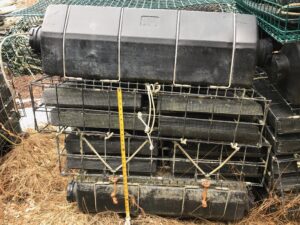
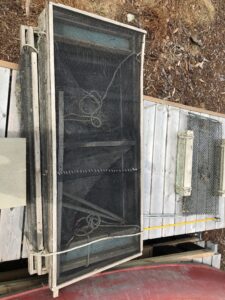 .
. 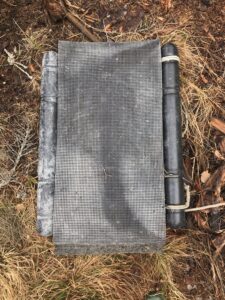 .
. 